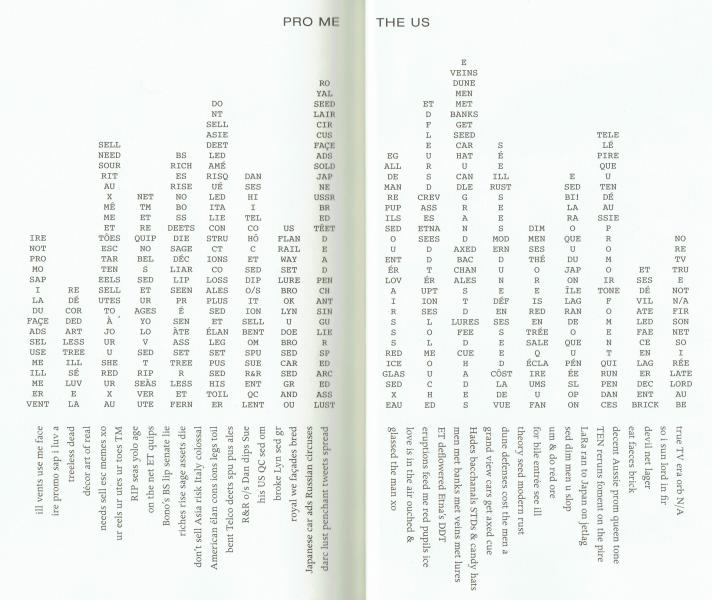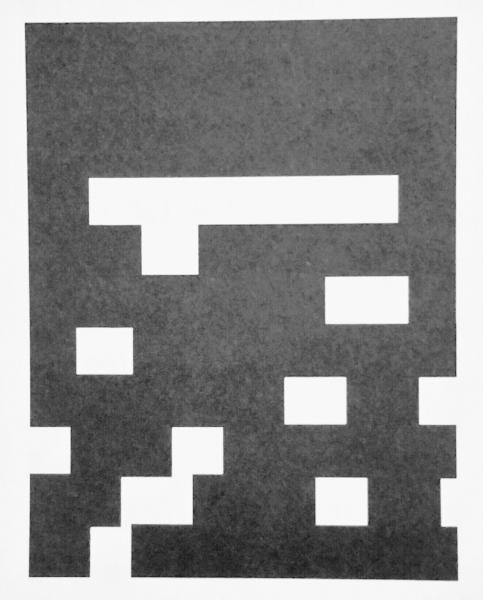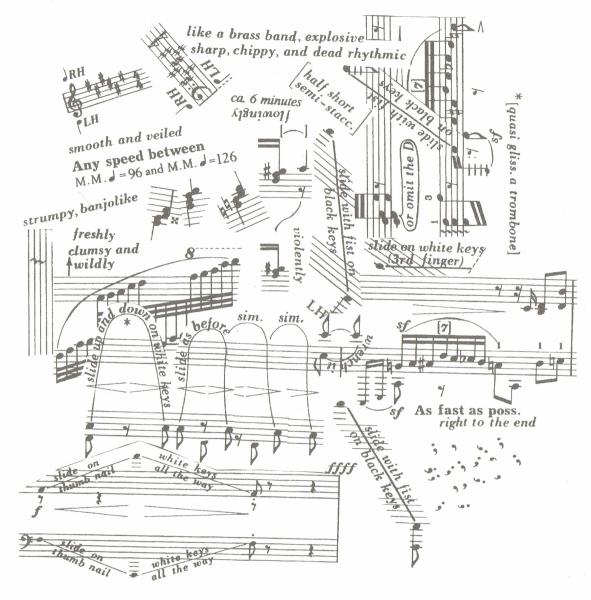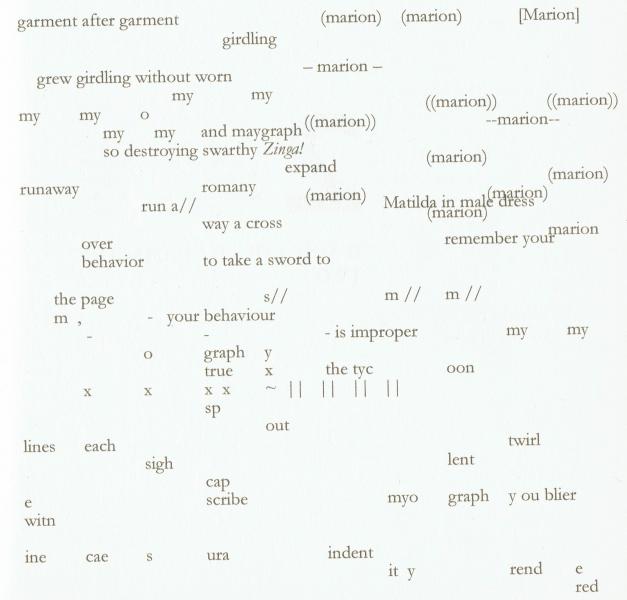The lives of the experimental poets 16–18
Fitch, Wilkinson, Lorange
16. Toby Fitch


Two versions of a poem, above in Otoliths (journal) the other in The Bloomin' Notions of Other & Beau (Vagabond 2016)
“To stick to things, to sail over them, both are wrong,” writes utopian Marxist philosopher Ernst Bloch in The Principle of Hope. In scenes of emergent Australian poetries, a new generation of experimental writers equipped with “radical hope” pursue the dream of the New as the avant-gardists did; but understanding that the way to do it is neither sticking to what has been (past vanguards) nor sailing over those works. So if it can be said that there really is no soi-disant contemporary avant-garde, and yet there is something like it, or something which might be mistaken for one, do we need to penalize these (mis)uses? In Australian poetry, as with many literary cultures, a certain official consensus has been built around what might constitute the “acceptable” poem, despite radical attempts otherwise. The three poets in this blog post have boldly written otherwise, developing three very different kinds of poetics.
We have tools to rehistoricize postwar and contemporary avant-gardes (via Tyrus Miller, via Brian Reed, others), and the things of the unofficial history we mention are not so far gone in the rapidly internationalizing “here” that is contemporary Australian experimental poetics. The history of concrete and visual poetry in Australia, a poetics-history not yet written, really begins with the 1981 anthology Missing Forms (Collective Effort) [also interior-titled Missing Form: Concrete Visual and Experimental Poems]. In discussing this lack of a history recently with Hazel Smith (and here I mean poetics history, a history of how these forms developed and showed a common or emergent writing that transformed individual practices), several reasons came up. One is, of course, the neglect of experimentation by a certain establishment that mandates and propagates a consensus poetics around what is perceived to be the correct way of writing verse. This versemaking is not versification but rather a settled form of vers libre via the well-mannered line. But another avenue is criticism itself. Criticism has yet to treat this work with the gravity it deserves. Shape, sound, segment, even spiral (in Fitch) as ways of reading the poem that warrant nuanced attention.
Born in London on December 2, 1981, and residing in Sydney, Fitch’s immediate family moved to Australia when he was three years old. Having gone to the University of Technology Sydney, Fitch has been crucial to the social life of poetry in Sydney, particularly his hosting the monthly Sapphos series named “AVANT GAGA.” More avant-pragmatist than sublime, Fitch’s poetics incorporates pictoriality, and otherwise is visual poetry, but no derivative neoconcretism. Not timid, nor tainted with the vanguardist’s masculine aggressivity, its plasticity works poem into shape and sound-shape, sculpting to move from objective to abjective, from percept to concept. Fitch takes up a full array of techniques as an experimental poet. We have instances of collage, blotting, concrete/pictorial poetry, and transliteration presented often with a certain conceptual unity. Works like Jerilderies (Vagabond 2014) take as source texts the 1879 Jerilderie Letter of bushranger Ned Kelly, “foraging” and “looting,” then packing and distending the original into rectangular blocks. Two pages end up voiding all language:


“Kelly’s Helmet,” Jerilderies, p. 5 “Helmut/QR code?” Jerilderies, p. 39
Whereas The Bloomin’ Notions of Other & Beau, Fitch’s most recent book, does antipodal “inversions” of Rimbaud’s Les Illuminations. With this latter work visual similarities with Mary Ellen Solt are evident particularly in the floral arrangements, but also horizontal “visual analogy” as the opening instance above shows, to paraphrase William Bohn on Joan Salvat-Papasseit and Catalan vispo. In the interior of Fitch’s poem-shapes he works, as did the avant-garde and neo-avant-garde concretists, with punning and the choral word; this work doesn’t outdo the analogy of shape, but adds an extra dimension that furnishes it.
The three poets I’ll speak of in this blog post resist the “make-it-profound” tendency in Australian poetry. I do think they are profound, in a sense, but in different ways they refuse middlebrow defeatism via nonconformist poetics; poetics comes first, at all costs, thinking about making is why these poets are inventive in the ways that they are. The radicalization of formal experiment is not an armchair task. It requires work, revision, reworking and refining, and constantly rethinking the political and ethical grounds of the poem. Experimentation does not mean antilyrical, but these poets trust the material word enough to let other kinds of language speak as lyric. If lyric, it’s a material lyric.
Fitch’s work is neither one of these things: processual, procedural, collagistic, or conceptual writing. These require critical differentiation, but it is worth pointing out that Fitch works variants of these together in a general experimental poetics, despite the differences and despite the variance in “result” (reading, listening, writing) and what ends up on the page. Collage isn’t quite procedure even if it involves processes. Collage is the building up of discrete elements, found or gathered, usually leaving each of those elements as units of pictorial communication or presentation. Procedure works with source texts, “following” a procedure (processual poetry, on the other hand develops a process). A collage poet, further, might think of their work as assemblage or bricolage, but they must do so in a nonliteral sense (it will mean differently in poetry than in the sculptural or visual arts). Erasure, deletion, indeterminacy, mistranslation or transliteration, are associated practices, but again they are not necessarily reducible to collage or procedure.
I think of Fitch as important to the lifeblood of Sydney experimental poetics as community, in the city. A concrete city like Sydney makes sounds. Anticipates future sounds. To break a mold. Mould? The city’s complex social ecologies. Fitch: celebrating what’s off-centre, catches us off-garde … making stale anew at fresh avant-centre. Language with which, or the same, colours? Fitch: feral itch turned complex heretic.
17. Jessica Wilkinson


Chorus from Suite for Percy Grainger Collage score from Suite for Percy Grainger
Let us sketch out an at least temporarily binarist opposition, as a thought experiment for two potential “misconceptions” of experimental poetics. Imagine that claims to experimentality (Australian-specific or not) have always simply been twofold: on the one hand there is the cryptoexperimental, on the other the alloexperimental. In the former, the experimentation is encrypted in the writing itself. You open a hypothetical (hypo-heretical?) book and in it a seemingly random group of letters appears on the page: WRGOABABD / MLIAOI /WTBIMPANETP / MLIABOAIAQC / ITTMTSAMSTGAB. There is no doubt that this book would have to be “experimental” in some way. There is a high likelihood it will be classed experimental by readers or reviewers. Those who want to decipher messages or meanings from the book will call it hermetic, closed, obscure, perhaps “elitist” as a result. Others who don’t want an immediate nugget of meaning will claim to be enraptured. You claim that if experimentality encrypts meaning it doesn’t lead to “nonsense.” It is, rather, productive of new meanings in the processes associated with poetic language, through formal variousness, through disjunctive poem on page and dissonant poem in ear.
A good deal of criticism understands this, and puts it into practice. Something more difficult might ensure though. For alloexperimental, using the prefix allo- (else, other), the action of experiment is elsewhere, other, in the enframing of an experimental work rather than encrypted in its interior languages. Conceptual poetries work closer to this fashion; the content of the work might be secondary, or, indeed, primary, but even if the content is, say, confessional lyric, the framing of that content is what makes it an experiment.
Such a binary is all too strict, and a good many examples of experimental poetry would make these unviable concepts. Wilkinson’s sense of experiment goes beyond both: there’s nothing necessarily cryptic (cryptoexperimental) in the language play — for it’s play, so it means — and it’s not all frame (alloexperimental) — though it gives clear concepts. Born November 30, in 1982 in country Victoria on a sheep and cattle farm, Wilkinson came to poetry through the study of myth in high school Latin classes. The collision of mythology, Ovidian subject matter, for instance, and the teaching of articulation in poems’ rhythm, prosody, stressed and unstressed syllables, drew her to poetry. As she says: “now I only write ‘poetic biography’” — longform biographical works in poetic form.
Wilkinson’s work is now quite constrained in its direction (generatively, not meaning closed), and it’s through this larger framework I think that two major conceptual cruxes emerge in Wilkinson’s work: 1) poetic inquiry into historical time and 2) the exploration of poetic subjectivity. Each book so far has explored a certain historical figure. Her most recent book, Suite for Percy Grainger (Vagabond, 2014) explores Grainger the Australian composer, arranger, and pianist (it was launched at the Grainger Museum in Melbourne), and Marionette: A Biography of Miss Marion Davies (Vagabond, 2012) takes as its subject the US actress Marion Davies (1897–1961) from which we get:

“Between score and scansion,” Marionette, p. 23

“Between score and scansion,” Marionette, p. 29
There’s no overlooking the fact of the dense, clashing visual surfaces (and the often reticulated layers) of Wilkinson’s pages; they can be compared with Susan Howe, on whom Wilkinson has done critical work. Alongside this, though, I want to read Wilkinson as a sort of dissonant prosodist. More than the mythos of the bios, the construction of a life, and more than poems-of-a-life, these are works whose fragmented, historical subjectivities are torn, or enrhythmed between, score and scansion.
In the above two excerpts, two clear examples of such score-scansion work are evident. As a kind of notational poetics, a term I’ve used to read North American long poems, the foot drops off the score (nearly off the page) such that a musical analogy crops up. The analogy asks us to read “music” as a virtual thing embedded in the body of the poem. Above that example note the scattered (marions) / ((marions)) / [Marions] leading us to scanned mark-ups that could very well be sounded in performance: x + |.
Wilkinson’s performances often break letters up into syllables, stopping and starting where the segment has become a broken foot. In her live performances we hear a kind of dissonant prosody or organic scansion. A “foot” is not so much versifed to the stanza but augmented in the “unsettled page” (Michael Farrell), a page that is always, entrancingly, a performance.
18. Astrid Lorange
I love. Binding stuff. The wrong way around. There: that’s a book.
— Pathetic Tower (2014)
Being a poet and a critic is no lofty way of doing things. I think of a poet/critic as firmly “grounded” on both ends, an unfolding possiblity not as a concrete achievement (though it requires the play of work, work of play). Poet/critics find themselves in testing circumstances; not as judge, or not always as judge, but very much as participant, maker, and reflector (often as a double career, maybe a kind of “double” life). Such a risker is more than risqué. The poet/critic moves fast, discarding and taking up practices, praxises … or slower (practise). But the poet/critic is no virtuoso in the musical sense. Yes, they work on the side of poetic technics itself. Sound, shape, segment. But then they want to know, or to engage with reasons why or how poesis connects to socius. In our times, increasingly urgent matters; questions of war and the more complex proposal of peace, critique of culture, political-economics, technoscience, ethics, capital, the body, its languages and chemicals, calamity, catastrophe. Doing all? Impossible, balancing but blasting, but one radically hopes.
I know no finer experimental poet-critic, maybe poet-“theorist,” operating in the Sydney surrounds, than Astrid Lorange. I stress this because there seems to be a continuation between her poetics — or, theories of poetry — and the poetry that gets written. What’s read or what gives way to readings becomes, or is, writing. This doesn’t happen all that often in Australian poetry now; we often see a disjunct between critical inclinations of the poet/critic and the poetry that the poet/critic writes, their aesthetics, their poetics. Perhaps it goes like this: practitioners (culturally) cringe at criticality, and critics elevate above the grit and grind of poetic work. Not so with Lorange. Doing is no elevation: writing is reading and thinking is practice. In her 2014 volume How Reading is Written: A Brief Index to Gertrude Stein (Wesleyan UP) Lorange, a Stein scholar but more than this too, outlines one aspect of her approach (plus, “affinities”):
Though this study is a reading of Stein, it does not argue for a specific interpretation of Stein’s work. Where interpretation seeks to elucidate meanings exegetically, I seek to explore itinerant modes of reading (rather than tracking Stein’s itinerant modes of meaning), in which one reads with and alongside texts. (22)
Lorange’s abstract-constructivist approach as critic is not to implement a conduit from theory to text, but as she says of her other thinker, Whitehead, a way of reading from text to theory and back; as Lorange writes, she comes to Whitehead through Stein. A text is also a book and Lorange in the epigraph above places herself before an unbound book, binds it almost the wrong way around, thinking the book. A book appears, like any other object, so a book might appear in a book, like an index. Not all books will have an index, be indexed. But what an index does is something like (so many things being alike) a score of relations, a vibration if you will between discourse and thought. The variousness of Lorange’s poetics engages uncompromising disjunction as well as what David Antin could call radical coherency. A recent poem, “Ex,” is some of Lorange’s most “radically coherent” poetry in this most abstract of senses:
After I wipe on pheromones,
I head out to not write poetry.
I’ve been an ex before and it feels
like not wearing your own
pheromones but someone or no
one else’s.
Or like never reading poems but
enduring the position of a poet.
I wipe some pheromones across
my face because I tend not to
sweat much.
Sweat is to a pheromone what an
ex is to poetry, that is, nothing.
Given the line breaks, which are fairly standardized in length (you could mistake the text for merely left-justified prose), the poem presents itself as an analogy of logics, almost-propositions, not as descriptions, of the body. It is a thinkerly poem and conceptual but I think confessional in the most subtle of senses (let me be frank, I say this as someone still unconvinced, broadly speaking, about the force of the confessional). I’d prefer to think of it as a kind of confessional or anticonfessional kind of “philosophical chemistry” to use Manuel DeLanda in that as these emanations of the body move around the body of the text, the reader thinks the vaporous emanations in relation to the poem itself: poetic chemistry can make analogous chiasmi: (natural) sweat to (artificial) pheromone is equivalent to the collocation ex / poetry. Both then disappear, as vaporous as they appeared, into nothing. The poem’s subject-object on the precipice of its own disappearing.
Lorange has often worked with sequences, not so much long poems as modular poems in serial array. Pathetic Tower is one such book, published in 2014 from Make Now press. Its sections are as follows: the first three poems are 1A, 1B, 1C, until section two which takes up the next twenty-one pages. Here is 1C:
1C.
Basically a series of concentric and differently materialised rectangles
Basically then a series of proportioned cylinders
Basically then a small assemblage of diverse organic entities
Basically then a definite set of major ‘large’ objects (desk, lamp, etc.)
Basically then also the ambient things: dust motes, scuff marks, pine smells
Basically then also the things related to my living body
Basically then the light and its effects
Basically also the camera and its one-minute-interval shutter dilations
Basically also Anna in the next room but not actually audible
Basically and critically a computer which is a very sophisticated machine
Basically and critically the books which each contain networking thinking
Basically and critically my telephone
Basically also but not very noticeably chips of paint & wood matter
Basically one last thing is a corner of the room in which storage bags are hidden
Basically then the line: “we were full on babies”
Less list poem as object poetics, one thinks, and as the poem goes on, so does the object-thinking in ways that circumvent or decry technocapital with a virtual body-object. The role of objects in Lorange’s work is key, because an object in a Lorange poem is not a unit of meaning, certainly not overdetermined. In a sense Lorange’s objects are underdetermined, they exist in poems as things which assemble as machines for making sense and making thinking or desire: “not to want sensuous objects or to want objects shy / and ghostlike, real as an expansion, in bunched or soiled slick knits / replacing it with a doc.” Poem objects have blurry borderlines, they avoid us, vaguely; sound, effect, smell, ambience, an experience, a concept. And then we’re not thinking about objects, though it seems we started with them. So the value (basically) becomes an object of inquiry (critically).
At that, Lorange’s work is deeply ex-perimental. Never derivative, it creates its own experience in language that is unexpected yet unsettlingly smooth, communistic and coherent in its thinking yet exploratory, vaporous, vague in its poetic chemistries. It is a critical poetics and by critical I mean the mind that is writing the poetry is also a poetics mind, “inter-fret,” anticapitalist, sociopoetic, teched-up in language phrased to give us every day a “lesson on refusal.”
The Lives of the Experimental Poets